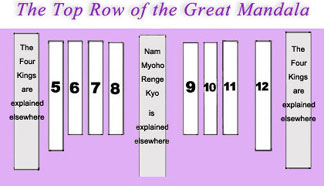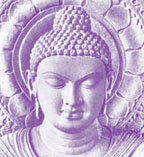

Note: The numbers correspond to those used in the Gohonzon Diagram.
#5 U kuyo sha fuku ka jugo — Those who make offerings will gain good fortune surpassing the ten honorable titles [of the Buddha]. The ten honorable titles are:
|
|
#12 Nyaku noran sha zu ha shichibun — Those who vex and trouble [the practitioners of the Law] will have their heads split into seven pieces.
From Lectures on the Lotus Sutra:
"Ikeda: These children represent 'befuddled' people. They are called 'befuddled' because, even though they are sick and desire to be cured, they refuse to take the medicine. The poison has penetrated so deeply that they have lost their ability to reason. They refuse the great beneficial medicine because they think it will taste bad. The 'Life Span' chapter says that their, minds no longer function as before' (LS16, 228). They cannot think rationally. It could be said that this is the state described as 'their heads split into seven pieces' (cf. LS26, 310)."Note: Tatsunokuchi Persecution: Nichiren Daishonin reminded Hachiman of his promise to protect the practioners of the Law or his “head will be broken into seven pieces.”
Nos. 6, 7, 10, 11 are the Four Bodhisattvas, who are Jogyo, Muhengyo, Jyogyo, and Anryugyo, the four leaders of the Bodhisattvas of the Earth described in the Yujutsu (fifteenth) chapter of the Lotus Sutra. According to Tao-hsien's Hokke Mongu Fusho Ki, they signify respectively the four virtues of the Buddha's life: true self, eternity, purity and happiness.
The significance of Bodhisattvas of the Earth (from the Selected Lectures on the Gosho, pg. 184) is:
The four bodhisattvas are often viewed collectively, indicating the life of the original Buddha, Nichiren Daishonin.To fight for happiness (Anryugyo) To carry on the movement to purify our lives as well as others (Jyogyo) To clear away the ugliness in society, just as the wind blows away dust (Muhengyo) To become an indestructible pillar in which anyone can place full confidence (Jogyo)
#6 Namu
Anryugyo Bosatsu [Bodhisattva
Firmly Established Practices]
Anryugyo (Sanskrit Supratishthitacharita) is one of the four bodhisattvas who are leaders of the Bodhisattvas of the Earth. Bodhisattva Anryugyo represents happiness.
Anryugyo corresponds to the element
“Earth” and has all the powers of earth (steadfast, stubborn, nourishing,
peace abiding).
#10 Namu Jogyo Bosatsu [Bodhisattva Superior Practices]
Jogyo (Sanskri Vishishtacharitra) — One of the four bodhisattvas and the leader of the Bodhisattvas of the Earth. Among these, Jogyo represents the virtue of true self. Nichiren Daishonin interprets Bodhisattva Jogyo as the provisional or ephemeral figure of the original Buddha of kuon ganjo projected at the Ceremony in the Air. Several of the Daishonin's writings refer to his own propagation efforts as "the work of Bodhisattva Jogyo," and the "Hyaku Rokka Sho" (The Hundred and Six Comparisons) identifies him as "the reincarnation of Bodhisattva Jogyo." In this respect, viewed from his provisional or transient status, Nichiren Daishonin is "the reincarnation of Bodhisattva Jogyo." However, his true identity is that of the original Buddha of kuon ganjo who appeared in the Latter Day of the Law.
Jogyo corresponds
with fire (because like fire it is always rising above the median). Jogyo
has all the powers of fire-like illumination.
From the Ongi Kuden, Gosho Zenshu, p. 710:
"'Fire' indicates the wisdom fire of the Buddha nature. As for its twofold significance, illuminating indicates the wisdom of true being that accords with the conditions, while burning indicates the principle of true being that is eternal. The two words 'illuminating' and 'burning' (further) indicate the essential and theoretical teachings. That which is endowed with these two virtues of fire, illuminating and burning, is Namu Myoho Renge Kyo."#7 Namu Jyogyo Bosatsu [Bodhisattva Pure Practices]“We burn the firewood of earthly desires and behold the fire of enlightened wisdom before our eyes.”
Jyogyo (Sanskrit Vishuddacharitra) — one of the four leaders of the Bodhisattvas of the Earth. Bodhisattva Jyogyo represents purity.
Jyogyo is
Pure Practices and has the power of water to wash away filth and reveal
that which is real.
#11 Namu Muhengyo Bosatsu [Bodhisattva Boundless Practices]
Muhengyo (Sanskrit Anantacharita) — One of the four bodhisattvas who lead the Bodhisattvas of the Earth. Muhengyo literally means no boundary and represents eternity, one of the four virtues of the Buddha's life.
Muhengyo
is the Bodhisattva that constantly clears away all boundaries. Muhengyo
is often translated as “Eternity” because he/she cannot be stopped even
by the boundaries of death. Muhengyo has all the power of the wind (the
wind is not stopped by anything) and blows away impurities.
![]()
#8
Namu
Shakamuni-butsu [Shakyamuni Buddha]

The historical historical founder
of Buddhism who is credited with the Lotus Sutra. Born about 3000 years
ago into a wealthy family, he began to seek enlightenment through various
austerities. When he finally embraced the Middle Way, he attained enlightenment
under a bodhi tree. He taught Buddhism for fifty years and his teachings
spread through India, China, Southeast Asia, and Japan.
Click here for a biography.
Click here for a large mandala in which Shakyamuni Buddha is the center.
#9 Namu Taho Nyorai [Many Treasures Thus Come One]
Taho (Sanskrit, Prabhutaratna) "Many Treasures": A Buddha who appears, seated within the Treasure Tower, at the Ceremony in the Air to bear witness to the truth of Shakyamuni's teachings in the Lotus Sutra. According to the Hoto (eleventh) chapter of the Lotus Sutra, Taho Buddha lived in the world of Treasure Purity in an eastern part of the universe. While still engaged in bodhisattva practice, he pledged that, even after he had entered nirvana, he would appear, in the Treasure Tower, and attest to the validity of the Lotus Sutra wherever anyone might teach it. In the Hoto chapter, Shakyamuni assembles all the Buddhas from throughout the universe. He then opens the Treasure Tower and at Taho's invitation seats himself at this Buddha's side.
T'ien-t'ai interprets Taho and Shakyamuni seated side by side in the Treasure Tower as the fusion of reality and wisdom (Japanese, kyochi myogo), with Taho representing the objective truth or ultimate reality, and Shakyamuni, the subjective wisdom to realize it. Moreover, Taho Buddha represents the property of the Law, Shakyamuni Buddha the property of wisdom, and the Buddhas throughout the universe, the property of action; together they represent the three properties. Nichiren Daishonin uses these interpretations of T'ien-t'ai and further states in the "Shoji Ichidaiji Kechimyaku Sho" (Heritage of the Ultimate Law of Life) that Shakyamuni and Taho represent, respectively, life and death, the two phases which the entity of life undergoes.
Taho is commonly translated
as "Many Treasures" or "Many Jewels." Nyorai means "Thus come
one." Therefore, Namu Taho Nyorai means "Devotion to Many Treasures
Thus Come One."